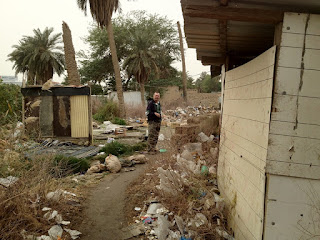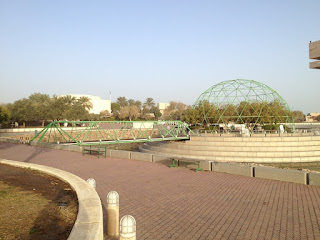Our last day began with a return to Green Island and it proved to be our most productive visit yet. The single
Hypocolious was located in it's favoured area and some great views were had by all. A pair of
Ruppell's Weavers shared the same small palm at the Hypocolious and we even saw the latter pinch a date from a weaver at one point! Ruppell's Weaver has yet to be admitted to category C of the Kuwait list but a pair present for about 3 years now and nest building could indicate it may be tickable one day. A newly arrived
Hoopoe, Red-vented Bulbul, White-cheeked Bulbuls and
30+ Starlings completed the passerines. The excitement wasn't over yet though because Bob had found a
Swift Tern sat on a buoy in the bay which quickly became 2. A
Caspian Tern and
4 Great Cormorants flew through before I turned my hand at photographing a nice close pale phase
Western Reef Heron. Finished with that I stated to look for a
Slender-billed Gull within photo range and the 3rd bird I looked at turned out to be an adult winter
Mediterranean Gull. I called to Pekka not fully realising the rairity of this species. He luckily got some quick views as it decided to fly and wasn't seen again. This constitutes the 6th record for Kuwait and was our guide's highlight of the week!
Hypocolious, Green Island
Ruppell's Weaver, Green Island
Swift Tern, Green Island
Swift Tern, Green Island
Western Reef Heron, Green Island
Mediterranean Gull, Green Island
En route to Pivot Fields we called in at the airport briefly but failed to re-locate the Indian Roller. Upon arrival at Pivot Fields access was problematic due to it being 'the prophet's birthday' (any excuse!) but we were eventually allowed in for just an hour. A necessarily quick whizz round revealed
1 juv Greater Spotted Eagle, 5 Black Kites and
2 Hen Harriers. 30+ Northern Lapwings with
1 European Golden Plover, 2 Green Sandpipers on the crocodile pool and
1 Hoopoe which showed nicely. Larks were much in evidence with
350+ Skylarks in a a huge flock and scattered
Crested Larks. 1 Daurian Shrike, 5+ Isabelline Wheatears, 1 Desert Wheatear, 1 Red-throated Pipit (heard only),
2 Chiffchaffs and a male
Siberian Stonechat completed the picture as we dashed for the exit.
Hoopoe, Pivot Fields
Despite our reservations (mainly concerning our rather fruitless visit a few days before) we returned to KABD again next. Weather conditions were pretty bad with a lot of blowing sand but amazingly, within minutes of arriving in the likely area a single lark flew past the car and we managed to stop and locate it sheltering from the conditions behind an isolated clump of grass. When we edged closer it was id'd as a very welcome
Dunn's Lark and the final piece of the jigsaw was in place for the group! Very shortly after that we saw 4
+ Black-crowned Finch-larks which was the icing on the cake. Spending a little time driving around revealed a few
Skylarks, Crested Larks and
Desert Wheatears and a
Red Fox crossed the track and moved quickly away.
Dunn's Lark, KABD
Black-crowned Finch-lark, KABD (copyright Pekka Fagel)
Our final site of our final day just had to be Jahra Farms. The species present were pretty much predictable but
30+ House Martins hinted at a little bit of a movement and another accipter teased us with several all too brief flight views. It eventually gave itself up as a male
Sparrowhawk but photographs clearly show an orange eye and a wing tip pattern showing only 4 prominent primary fingers. All going to prove we have more to learn about the id of Shikra!
Sparrowhawk, Jahra Farms
The tour was over and had been a huge success, helped by hard work and with a little bit of luck thrown in!




















































